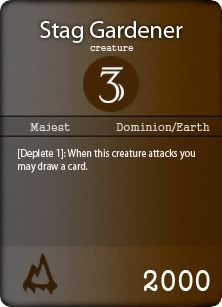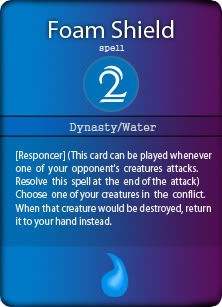There are four Quadrants, within which there are eight Elements.
Quadrants: Affinity, Dynasty, Dominion and Regency.
Elements: Radiance, Wind, Ice, Water, Gravity, Earth, Fire and Lightning.
The image below shows how Elements are distributed among the four Quadrants. Please note four of the eight elements are overlapping elements and present in two Quadrants, for example Radiance is present in both Affinity and Regency.

Each deck must contain exactly 40 cards, no more, no less.
You can only have a maximum of 4 copies of each card.
There are three main cards types which include Creatures, Spells and Runes. The image below shows how different parts of each card are represented on the template images.

In Chaos Fractal the cost for summoning creatures and casting spells is paid with Tempo (which is similar to mana in some ways).
Each player starts with 0 Tempo and gets 1 free Tempo at the start of each of his turns.
Everything costs Tempo (creatures , spells etc...). Used Tempo gets recharged at the start of each turn.
Both players start with 5 Grid Points each and when a player has zero grid points left, and gets attacked directly he loses the game. You also lose the game if you deck-out i.e draw your last card.
Both players have 5 cards in their hand at the start of the duel. The player who wins the toss decides who goes first. The player that goes first does not draw a card at the start of his turn, but does get +1 free tempo at the start of his turn.
Whenever a player losses a Grid Point, he gets +1 Tempo. So for example if your opponent damages two of your Grid Points, you gain +2 Tempo.
A player losses one of his grid points when the opponent manages to attack him directly without being blocked. This is known as taking Damage.
When a creature enters the conflict (battle zone), it is said to be a Disoriented state (summoning sickness) unless it has [Born Ready] (speed attacker). A creature only remains Disoriented for one turn, which is the turn it is summoned.
To summon a creature or cast a spell you must pay a certain amount of tempo cost indicated on the card. For that you expend the required tempo. That tempo is considered to Depleted and cannot be used again until the start of your next turn.
When a creature is placed in the conflict area its placed in a Ready state (untapped). When it attacks it goes into an Exhausted state (tapped). If a creature is already exhausted, it can not attack or block. All creatures on a players side of the conflict become Ready at the start of his turn. You can only attack exhausted creatures on the opponent's side of the conflict or attack the opponent's Grid.
After the summoning/casting phase comes the Battle phase. During this phase you may exhaust one of your creatures to attack either your opponent or one of his creatures. Then if your opponent has a blocker, he chooses whether to block or not and then battle happens or damage it taken.
Another important part of Chaos Fractal is Cost Reduction. Each Creature and Spell had its cost reduced by the number of creatures of the same element that you have in the conflict. They can't cost less than 2.
So for example if you had 5 Earth Creatures in conflict , summoning Archaic Rumble(Cost 9/Earth) would only cost you only 4 tempo (9 minus 5).
The Duel Window:

1 - The Tempo Zone : Here you can see both yours and the opponents tempo. Green indicates the number of your unused tempo and Gray the depleted one . You can also check the current tempo on the lower left side of the screen.
2 - The Battle Zone : Here is where all creatures/runes and spells are played.
2.a - Grey units indicates they are exausthed.
2.b . Non Gray units indicates that they are ready to attack (if they dont suffer from desoriented state)
3 - The Hand Zone : Here you can see and use the cards currently in your hand.
4 - The Status Panel : Here you can access information on both players situation such as hand size,tempo,grid,cards left in deck etc... Also you can check whose turn it currently is by looking beside the players name. If the player has a small start besides its name it indicates that its his current turn.
5 - The Tab Panel : In this pannel you can change view of other parts of the game area such as your grave or your opponents grave.
6 - Card Template : You can see card templates here. (more on this later)
7 - Card Details : Here you can check card details. (more on this later)
8 - Log : In this area you can check the duel log such as moves played by your opponent or messages you wrote for example.
9 - Chat : With this part you can message your opponent with a message you might want.

6 and 7 - By clicking on a card in the duel window its infrmation will be displayed on the right side. Everything you want to know its displayed.
10 - By rightclicking a creature you can find out his owner and its name.

When you right click a creature you'll have several actions available in it such as move to a certain area (grave,hand,field...) exauhst , ready , exauhst for attack or for effect.
Activate Effect works for the Runes effects.
Races:
Chaos Fractal consists of a variety of different races distributed between each element. Most races have creatures that belong to only one element, where as some creatures are found in multiple elements. Click here to discover more about Chaos Fractal races.

Game Mechanics:
[Deplete] : A creature with this ability can activate it by paying specified cost (this is separate from the cost required to summon it to play a certain ability).
- Example 1:

Name: Stag Gardener
Type: Creature
Race: Majest
Cost: 3
Power: 2000
Rules text: [Deplete 1]: When this creature attacks you may draw a card.
Element: Earth
Quadrant: Dominion
Whenever this creature attacks you may pay the cost by depleting one of your un-used Tempo to activate the [Deplete 1] effect. This tempo will be usable in your next turn. You may not deplete tempo that has already used/depleted this turn.
Example 2:

Name: Skylia
Type: Creature
Race: Luminaire
Cost: 4
Power: 5000
Rules text: [Blocker] This creature can't attack players. [Deplete 3]: This creature gets +3000 power until the start of your next turn.
Element: Radiance
Quadrant: Regency
In cases such as this where its not stated when you have to pay the deplete cost, it should be assumed that you have to pay the cost before the start of your Battle phase. This effect, as stated, only lasts till the start of your next turn, so if you wish for this creature to gain this ability again in your next turn, you will have to pay the cost again by depleting three un-used tempo.
Also note that the above creature is Radiance, which as you already know is an overlapping element. Although the element Radiance is present in both Affinity and Regency (as shown previously), the point to note is that a Radiance creature, or any card for that matter, can only belong to one Quadrant at a time. Skylia is a Radiance creature that belongs to the Regency quadrant.
- Example 1:

Name: Phoenix Alicia
Type: Creature
Race: Aztotl
Cost: 2
Power: 1000
Rules text: When this creature would be destroyed, you may [Consume 1]. If you do, return this creature to your hand instead.
Element: Fire
Quadrant: Regency
What this effect means is that when this creature is destroyed, you have the option to consume one of your Tempo to return it to hand. Unlike Depleted tempo, consumed tempo if lost forever, and does not refresh at the start of your next turn. Also unlike Depleting tempo, in the case of Consume you can choose to consume a tempo that is already used (this is similar to how you can destroyed tapped mana).
Example 2:

Name: Indura
Type: Creature
Race: Valkyrie
Cost: 6
Power: 5000
Rules text: Whenever this creature attacks, consume one of your opponent's tempo.
Element: Ice
Quadrant: Dynasty
This card is a good example of typical Ice creature. You can imagine how Ice is trying to freeze the opponent and by tempering with his resources. As far as how the card works, its very simple. The creature attacks, your opponent gets -1 tempo.
Cards with [Responcer] can also be played during your opponents turn. A creature or spell with responcer can be played right after a player has declared an attack for its responcer cost. If a responcer cost is not specified it should be assumed that you have to pay cost equal to the actual cost of the card. As always you will need to have enough un-used/undepleted tempo to pay the cost.
In the case your opponent attacks you with a creature and that creature does damage (i.e destroys one or more grid points), the tempo you gain when the a grid point is damaged can be used to pay the responcer cost.
- Example 1:

Name: Genesis, The Divine
Type: Creature
Race: War Dragon
Cost: 5
Power: 2000
Rules text: [Responcer 3] (When your opponent attacks, you may summon this creature for the Response cost) When this creature enters the conflict, destroy one of your creatures. Then your opponent chooses and destroys one of their creatures.
Element: Fire
Quadrant: Regency
Imagine at the end of your turn you are left with 2 un-used tempo. Then during his turn, your opponent attacks your grid points with one of your creatures. When grid is damaged you gain 1 Tempo (because that's the rule: -1 Grid +1 Tempo). After the attack you now have 3 un-used tempo, which can be used to pay for Genesis, The Divine's responcer cost, allowing you to summon Genesis at the end of your opponents attack, after which Genesis' effect takes place.
Example 2:

Name: Foam Shield
Type: Spell
Cost: 2
Rules text: [Responcer] (This card can be played whenever one of your opponent's creatures attacks. Resolve this spell at the end of the attack)\nChoose one of your creatures in the conflict. When that creature would be destroyed, return it to your hand instead.
Element: Water
Quadrant: Dynasty
Responcer spells work the same way the creature ones work. There are two things that you should know. Firstly you can actually simply cast Spells that have Responcer during your own turn, you will however of course be paying their actual cost regardless of there being a specified Responcer cost.
Secondly when you trigger Responcer effect (always during opponents turn after they attack), the effect takes place at the end of the attack, which is before the creature is sent to the graveyard. This is why if your opponent attacks one of your creatures and you trigger the responcer above (Foam Shield), your creature is returned to hand instead of being destroyed.
[Toxic] : When a creature with [Toxic] losses a battle, the opposing creature also losses even if it has a higher power. Both creatures are destroyed.
[Unique] : You may not have two or more cards with the same name as a card that has [Unique] on your side of the conflict . If you do, destroy one of them immediately.
These were the basic rules and mechanics, I hope I was clear enough in my explanation. If you have any questions feel free to ask in a reply to this topic.
The best way to understand how the game works is to play the game.
Good luck, and Enjoy!